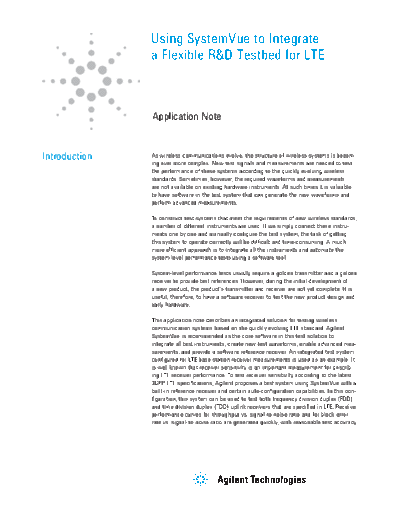Service Manuals, User Guides, Schematic Diagrams or docs for : HP Publikacje 5990-6202EN
<< Back | HomeMost service manuals and schematics are PDF files, so You will need Adobre Acrobat Reader to view : Acrobat Download Some of the files are DjVu format. Readers and resources available here : DjVu Resources
For the compressed files, most common are zip and rar. Please, extract files with Your favorite compression software ( WinZip, WinRAR ... ) before viewing. If a document has multiple parts, You should download all, before extracting.
Good luck. Repair on Your own risk. Make sure You know what You are doing.
Image preview - the first page of the document

>> Download 5990-6202EN documenatation <<
Text preview - extract from the document
Using SystemVue to Integrate
a Flexible R&D Testbed for LTE
Application Note
Introduction As wireless communications evolve, the structure of wireless systems is becom-
ing ever more complex. New test signals and measurements are needed to test
the performance of these systems according to the quickly evolving wireless
standards. Sometimes, however, the required waveforms and measurements
are not available on existing hardware instruments. At such times it is valuable
to have software in the test system that can generate the new waveforms and
perform advanced measurements.
To construct test systems that meet the requirements of new wireless standards,
a number of different instruments are used. If we simply connect these instru-
ments one by one and manually configure the test system, the task of getting
this system to operate correctly will be difficult and time-consuming. A much
more efficient approach is to integrate all the instruments and automate the
system-level performance tests using a software tool.
System-level performance tests usually require a golden transmitter and a golden
receiver to provide test references. However, during the initial development of
a new product, the product's transmitter and receiver are not yet complete. It is
useful, therefore, to have a software receiver to test the new product design and
early hardware.
This application note describes an integrated solution for testing wireless
communication systems based on the quickly evolving LTE standard. Agilent
SystemVue is recommended as the core software in this test solution to
integrate all test instruments, create new test waveforms, enable advanced mea-
surements, and provide a software reference receiver. An integrated test system
configured for LTE base station receiver measurements is used as an example. It
is well known that receiver sensitivity is an important measurement for describ-
ing LTE receiver performance. To test receiver sensitivity according to the latest
3GPP LTE specifications, Agilent proposes a test system using SystemVue with a
built-in reference receiver and certain auto-configuration capabilities. In this con-
figuration, this system can be used to test both frequency division duplex (FDD)
and time division duplex (TDD) uplink receivers that are specified in LTE. Receiver
performance curves for throughput vs. signal-to-noise ratio and for block-error-
rate vs. signal-to-noise ratio are generated quickly, with reasonable test accuracy.
Test System Structure and Functions
The basic configuration of the integrated test system, shown in Figure 1, includes
the SystemVue software, a device under test (DUT), and instruments such as
vector signal generators with deep ARB memory, vector signal analyzers with
deep capture memory, and a channel emulator. In this configuration, baseband
data is generated by SystemVue and sent to the PXB channel emulator. Faders
can be used in the channel emulator to set up single input-single output (SISO)
or multiple input-multiple output (MIMO) channels with multipath fading. The
signal generators, driven by the channel emulator, generate receiver RF and
IF signals that are used for testing the DUT. The signal analyzers capture the
received signals from the DUT outputs and send them back to SystemVue. In the
SystemVue platform, the software receiver can demodulate, deframe, and decode
received signals and provide a measure of receiver performance. In Figure 1, the
test data flow is indicated by the red arrows.
SystemVue plays the key role in integrating all the instruments in the test
system. The flow of test system control is shown in Figure 1 by the blue arrows.
The main functions of SystemVue include the following:
◦ Jabse Service Manual Search 2024 ◦ Jabse Pravopis ◦ onTap.bg ◦ Other service manual resources online : Fixya ◦ eServiceinfo